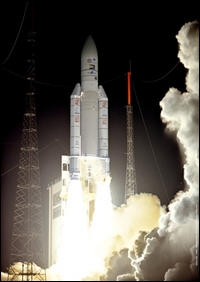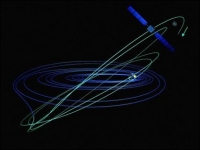Launch Phase
 |
|
Launch of Ariane flight 162 |
 |
|
SMART-1's journey to the Moon |
The commissioning of the electric propulsion (EP) system started on 30 September (during the fourth orbit) with a venting of the xenon subsystem to eliminate the presence of any water vapour and oxygen. The initial test of the EP consisted of a 50 minute firing on the primary cathode, a 6 minute sequence at full power on the redundant cathode, and a second firing on the primary cathode for 2.5 hours.
Apogee Raising
After proving the EP's successful in-flight operation, the engine was fired periodically over the first months of the mission to increase the orbit's semi-major axis. The firing occurred once per orbit at perigee (closest point to Earth), resulting in a large accumulative increase in the apogee height and a smaller increase in the perigee height.
From 30 January to 24 February 2004 the EP was inactive for a period of just over three weeks. The resulting stable platform conditions allowed the commissioning of the scientific instruments. At that point the total cumulated thrust was more than 1700 hours, with the EP system consuming 27.1 kg of xenon and providing a velocity increment of about 1220 ms-1 (4392 km per hour).
On 24 February 2004 operation of the EP drive was resumed. The engine was fired every orbit around perigee for about 1.5 hours. This was followed by a new strategy at end of March 2004 with an 8 hour burn around perigee, with the purpose of rapidly boosting the orbit. Over the following months the thrust duration increased as the orbit expanded. The longest thrust arc was on 9 August 2004 and lasted 56.7 hours. In mid-August, the thrust strategy was re-optimised in order to take into account the actual engine performance and consisted of alternating long and short thrust arcs.
Lunar Resonances
Although still inside the Earth's gravitational sphere of influence, SMART-1 experienced an increasingly stronger pull from the Moon as the spacecraft's orbit continued to expand. At regular intervals (27.4 days), the orbit was altered by a lunar resonance which occurred while SMART-1 was at apogee. The first of these resonances took place on 19 August 2004, 17:56 UTC, when the spacecraft was approximately 197 000 km from the Moon and 230 000 km from Earth.
| Resonance | Time | Ratio of Orbital Periods SMART-1:Moon |
| 1 - 19.08.04 | 17:56 UTC | 5:1 |
| 2 - 15.09.04 | 01:07 UTC | 4:1 |
| 3 - 12.10.04 | 03:18 UTC | 3:1 |
| 4 - 15.11.04 (Lunar Capture) |
17:47 UTC | 2:1 |
The last firing of the EP before lunar capture was a thrust arc around the third lunar resonance, and ended on 14 October 2004. Apart from a 4 hour correction burn on 25 October, the EP remained inactive until lunar capture. Up to 26 October, and the 289th engine pulse, the SMART-1 EP system had cumulated a total on time of nearly 3650 hours, consumed about 59 kg of xenon and imparted to the spacecraft a velocity increment of approximately 2735 ms-1 (9850 kmh-1).
On 11 November 2004, four days before lunar capture, SMART-1 crossed the first Lagrange point of the Earth-Moon system and made the transition from an Earth-bound orbit to a Moon-bound orbit.
Status Reports Coverage
The period from launch up to the crossing of the first Lagrange point is covered in the status reports from no. 1 to no. 31.
